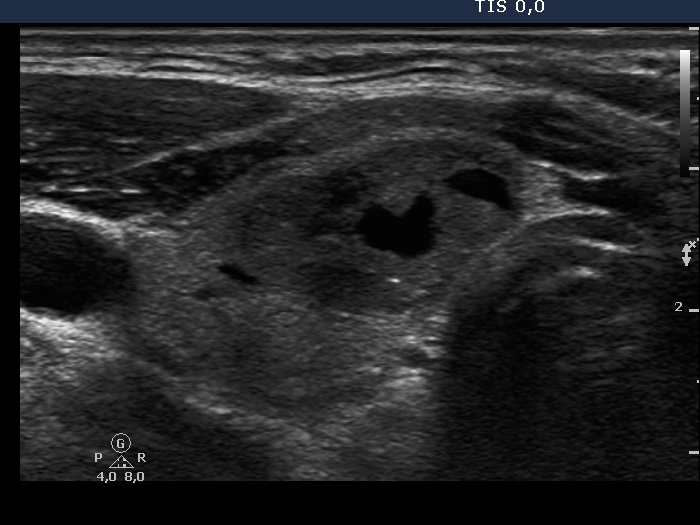|
|
Secondary thyroid carcinomas - Case 1.Metastasis of a clear cell adenocarcinoma of the kidney |
|
Clinical presentation: A 51-year-old man requested a second opinion. He was examined because of a thyroid nodule in the right thyroid detected by himself. This lesion proved to be benign on cytology, but the cytology of another nodule in the left lobe raised the possibility of medullary thyroid cancer. Calcitonin-immunocytology yielded a "weak positivity". Serum calcitonin level was normal (below 0.59 pM/L). Surgery was planned.
Palpation: There was a firm nodule in the right lobe, while no nodule was palpable in the left thyroid. An enlarged, not freely moveable lump was found in the left submandibular area.
Functional state: euthyroidism with TSH-level 0.91 mIU/L.
Ultrasonography: There was a moderately hypoechogenic nodule with increased intranodular blood flow in the right thyroid, while a smaller hypoechogenic lesion in the medial part of the left lobe. The latter also displayed intranodular vascular pattern. Corresponding to the lump in the left submandibular area, there were enlarged lymph nodes with an irregular vascular pattern.
Cytology was performed both from the lesion in the left thyroid and from the enlarged lymph node and resulted in the same pattern. Atypical, partly pleomorphic tumor cells were found which were arranged in small groups and acini. They had abundant cytoplasm with small vacuoles. We determined thyroglobulin in the wash-out of the needle, which resulted in undetectable levels.
Final diagnosis: metastasis of an adenocarcinoma to the thyroid and neck lymph node.
Further evaluation and surgical exploration of the patient revealed a clear cell adenocarcinoma of the kidney with metastasis to the liver and the lung.











